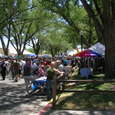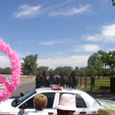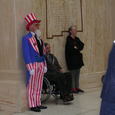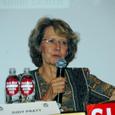« Petition: Put Paper Ballots on National Dem Agenda | Main | Saturday Music Hall: Graceland »
Friday, December 01, 2006
Generation Dem
 More good news for Dems: voters under 30 supported Democrats by significant margins in the November election. According to an article examining 2006 election trends by Sidney Blumenthal, "the momentous 2006 elections signaled the emergence of a younger, bluer America that could reshape politics for years to come. Blumenthal describes a "younger generation that is overwhelmingly Democratic." Tidbits:
More good news for Dems: voters under 30 supported Democrats by significant margins in the November election. According to an article examining 2006 election trends by Sidney Blumenthal, "the momentous 2006 elections signaled the emergence of a younger, bluer America that could reshape politics for years to come. Blumenthal describes a "younger generation that is overwhelmingly Democratic." Tidbits:
While voters under 30 were the most favorable age group in 2004 for Kerry, casting 54 percent of their votes for him, Democratic House candidates in 2006 received 60 percent of their votes, compared with 38 percent for Republicans.
Nationally, partisan identification breaks 38 percent Democratic to 35 percent Republican, but among those under age 30 the percentages are 43 to 31 in favor of Democrats. This pattern runs as strongly in the West as in the East, the Midwest and the Pacific states, a clear indication that the Western states are heading out of the Republican camp -- out of alliance with the deep South's Republican states and into coalition with the broad majority.
In Wyoming and Arizona, where Republicans won elections for the House and Senate, the Democrats would have won by 16 and 15 points, respectively, if the elections had been conducted only among under-30s. In Montana, where Democrat Jon Tester won by 1 percentage point, fewer than 3,000 votes, his margin among under-30s, who were 17 percent of the electorate, was 12 points.
Bush has been the formative political experience for the youngest generation of voters, those 18 to 30. Studies of voting preferences show that the experience imprinted on a generation in its 20s largely determines its future political complexion. This generation is the most Democratic generation ever -- more Democratic than the youngest voting generations of the New Deal and the 1960s.
Blumenthal also analyzes demographic data generally and in other categories. His findings are strongly positive for Dems almost across the board. Excerpts:
Exit polls showed that the Democrats won the popular vote by 52 to 46 percent. Given that Bush won the popular vote by 3 points in 2004, this was a reversal of not 6 but 9 points. An analysis of the actual popular vote for the Senate, however, reveals an even greater Democratic margin of 55 to 42.4 percent. That number also coincidentally corresponds to the margin by which Democrats won women, the greatest margin since 1988. Yet Democrats won independents by an even bigger margin, 18 points, the greatest spread in House races in 25 years. The profile of independents on issue after issue now mostly resembles the profile of Democrats.
One of the largest shifts appeared among Hispanics, the group that Rove targeted most intensively for six years. In 2006, Hispanics went for the Democrats 69 to 30 percent, a 10-point increase in the spread from two years ago. Unpopular as Bush may be today, he has been the most accessible Republican to Hispanics ever, a Spanish speaker from a state with a large Hispanic population. Next time, in 2008, the Republicans do not have a potential candidate who can remotely approach Bush's appeal.
The dramatic turnover of both the House and the Senate should not obscure the profound transformations going on in the states, where 10 state legislative chambers switched to the Democrats, and, as political analyst Charlie Cook points out in the National Journal, "the Democratic advantage over Republicans in state legislatures went from 15 seats (3,650 versus 3,635) to 662 seats (3,985 versus 3,323), with gains in every region.
There's certainly much to celebrate in the 2006 election results. Just think how much more we can improve our chances for victory in 2008 and beyond IF Dems across the nation take the reins and dedicate themselves to representing ordinary people and the core Democratic values of fairness, opportunity for all, common sense and the common good. More and more Americans -- particularly younger voters -- have caught on to the lies and manipulations employed by rightwing Repubs to try and fool all of the people all of the time. Clearly, the Dem Party needs to accellerate outreach to younger voters and take full advantage of the trend building for a Generation Dem. Let's hope DNC Chair Howard Dean's 50-state strategy places a strong emphasis on reaching out to young voters.
December 1, 2006 at 11:11 AM in Candidates & Races, Democratic Party | Permalink
Comments
YES!!!!
Posted by: nancy | Dec 1, 2006 4:24:01 PM
*"Senate Democratic margin of 55 to 42.4 percent----- *Democrats won independents by an even bigger margin, 18 points---- *Hispanics went for the Democrats 69 to 30 percent". These numbers are what Rush and other Reich wing nut talking heads as well as some Reich wing blogs are calling a "FLUKE" ???
Posted by: VP | Dec 1, 2006 4:50:58 PM









